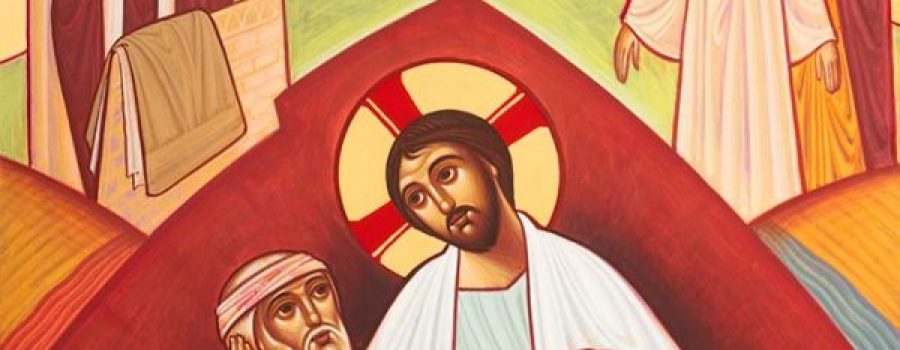Coptic Gospel Responses (chanted after the selected pericope of the day) allow the members of the Church to engage with the passage of the gospel that was read over them. In many cases, the responses vary from one parish or monastery to another; in compiling them, we find a number of stanzas for each pericope—forming a beautiful exegetical tapestry.
While a friend and I were compiling and translating some of the responses for Lent, we stumbled upon a single stanza that was unattested in all the other manuscripts we were analyzing.

While the responses for the Vespers and Synaxis (Liturgy of the Word) gospel pericopes match the selected reading in the common rite, the response for the Matins reading references a completely different pericope. Let’s have a look at the text:

Remembering the ⲃⲱϩⲉⲙ of Saint Mena (ⲁⲓϧⲉⲧ ⲛⲓⲥⲏⲓⲛⲓ), the word ⲉⲣϧⲟⲧ “wound” turned my mind to the Parable of the Good Samaritan.
At first glance, I thought the response might have been misplaced, so I searched the ⲕⲁⲧⲁⲙⲉⲣⲟⲥ to see when the Parable of Good Samaritan was read during the Lenten period. Surprisingly, I found that this parable was not read during Lent at all; in fact, the only instance where this pericope is read throughout the Coptic year is the third Sunday of ⲡⲁϣⲱⲛⲥ (this gospel response, however, is not mentioned on that occasion). All this leads me to venture a hypothesis that, at least in the region where this manuscript was utilized, it is possible that the pericope of Matins of the Fourth Sunday of Lent was the Parable of the Good Samaritan. This pericope would also align with the gospel of the synaxis being that of the Samaritan Woman, rendering the whole day as a “Samaritan Sunday” of sorts! (This framework isn’t unheard of in the Coptic Rite; at times for certain saints’ feasts, all the readings are selected because they may have the name of that saint in them).
On another note, I want to take a moment to analyze what this response is actually doing, textually. First, it interprets Christ Himself to be the Good Samaritan! Our Lord is the one who does not ignore the down-trodden and beaten, even those half dead (and those dead four days), but binds up their wounds. The Coptic verb ϧⲱϧ B; ϩⲱϩ S literally means to scrape or rub, depicting Christ as tending to the wounds of the fallen one, scrubbing from them their impurities, pouring on them oil and wine, and caring for him. The use of the term ϣⲉⲛϩⲏⲧ alludes to verse 33, “But a Samaritan walked, he came up to him, and having seen him, had compassion;”. Finally, the response puts us in the place of the man stripped, beaten, wounded, and left for dead, pleading with Christ to care for us as He did then.
And here, I borrow this quote from the artist behind this beautiful icon—Kirollos Kilada:
“The man who was going down is Adam. Jerusalem is paradise, and Jericho is the world. The robbers are hostile powers. The priest is the law, the Levite is the prophets, and the Samaritan is Christ. The wounds are disobedience. The beast is the Lord’s body. The [inn], which accepts all who wish to enter, is the church. The two denarii mean the Father and the Son. The manager of the stable is the head of the church, to whom its care has been entrusted. The fact that the Samaritan promises he will return represents the Savior’s second coming….The Samaritan, “who took pity on the man who had fallen among thieves,” is truly a “guardian,” and a closer neighbor than the Law and the Prophets. He showed that he was the man’s neighbor more by deed than by word. According to the passage that says, “Be imitators of me, as I too am of Christ,” it is possible for us to imitate Christ and to pity those who “have fallen among thieves.” We can go to them, bind their wounds, pour in oil and wine, put them on our own animals, and bear their burdens. The Son of God encourages us to do things like this.” –Origen of Alexandria
If all this information can be drawn from one stanza of four lines from just one manuscript, how much more spiritual benefit can be ascertained from the entire liturgical corpus of our Church?
A blessed Lent to you all!
UPDATE: I found that Bishop Samuel also recorded this gospel response from the Baramous Monastery manuscript as an option for Matins of the 4th Sunday of Lent.


Leave a Reply
Your email is safe with us.